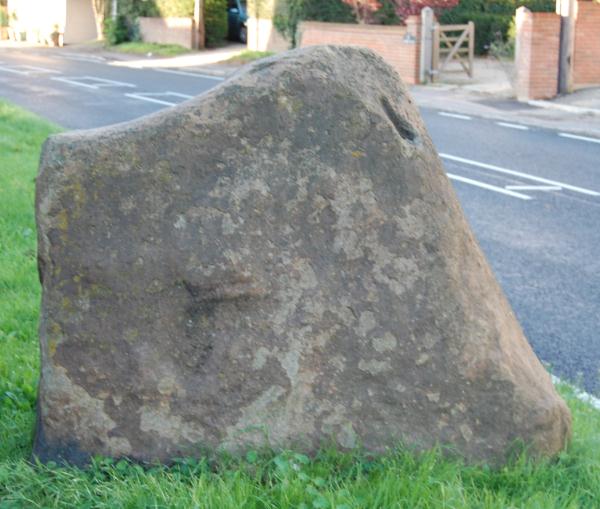Giant boulders can be found at many locations in Essex. Some are on road verges, river crossings, near farm gates, crossroads, hilltops, and fords. Others may seem randomly dispersed across the county. They occur in two forms: Puddingstones or Sandstone Sarsens. This example in Newport is a Sarsen stone.
The geological origin of these unique boulders is thought to be the sands and pebble seams of the Reading Bed which may have been exposed to the surface when Essex was very hot and dry some 20 million years ago. During this time, water with dissolved silica would have been drawn to the surface and the sands and pebble beds would have become cemented by silica, thus forming tough sandstones (Sarsen stones) and conglomerates (Pudding stones). Erosion would have broken up the river beds and these large, hard blocks scattered by glaciers and rivers during the Ice Age.
The sandstone boulders, or sarsens, are very common in Essex occuring set in the ground as landmarks or built into walls, particularly in North-West Essex. The other distinct boulder found in Essex is known as 'Hertfordshire Puddingstone' due to it mainly occuring in Hertfordshire (A county next to Essex) and its resemblance to a plum pudding. Puddingstone occurs in some Hertfordshire quarries as a layer and is made up of well-rounded flint pebbles. Puddingstone is sometimes confused with other cemented gravels, however the difference is that with Puddingstones the pebbles and enclosing matrix are the same hardness and if it is broken the plane of fracture passes through (rather than around) the pebbles.
It is thought that these stones were of great religious importance to early man and there are still many myths and legends about their location and formation due to their placement often seeming like they are marking an important landmark. It is thought that such large boulders were regarded as being so special, as Essex is very rich in Saxon finds, and Roman Roads and in an area where such large stones were quite rare, it is somewhat surprising that they weren't broken up and used for building work. Because of their usefulness, it is reasonably certain that not many of them remain in the same position as when they were deposited from the ice.
The example of a Sarsen stone at the coordinates listed for this earthcache is known as 'The Leper Stone'. The origins of its name are thought to have come from the fact that it was once situated alongside a leper hospital. At the stone food was supposedly left for the lepers who were lodged at St Leonard's Hospital nearby. Excavations for the new houses that stand on the site near the stone, did reveal human bones but although these were proved ancient, they did not show any signs of leprosy.
This example is the largest standing sarsen stone in the whole county of Essex and it is wondered how it reached the position that it is in. Could a stone falling from a melting glacier really stand itself on its end like this one has? There is also an example of a Puddingstone in this same village just down the road along Station Road (outside the Village Hall).

|

|
|
Facing away from Newport
|
Facing towards Newport
|
The coordinates will take you to the Sarsen stone at the side of the road at the entrance to Newport. Parking is on the side of the road near to the stone. Please park safely.
Please email the following to us to claim this as a find:
1. Name a very famous landmark in the UK that features Sarsen stones.
2. Describe the colour and texture of the granular material that makes up this stone.
3. Sandstone is a sedimentary rock, but what is most sandstone composed of?
4. Look at the side of the stone that is closest to the path. Describe the bottom section of the stone in detail (i.e. not just the colour).
5. Either get someone to take a picture of you with your GPSr, or take a picture of your GPSr with the stone in the background.
Please email us the answers to 1, 2, 3 and 4 and post your photo in your log. Do not post the answers to 1, 2, 3 and 4 in your log. Logs with this information in will be deleted. Logs MUST include a photo, and answers must be emailed to us. You must complete all 5 tasks for your log to be allowed.